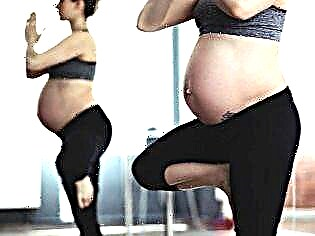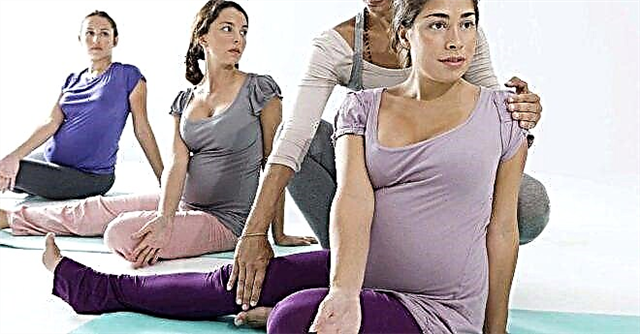
Yoga is not just a complex of physical exercises, but also a set of spiritual, mental practices, the purpose of which is to bring the body into a harmonious state. Russians were interested in ancient art even in pre-revolutionary times, but the first yoga school was opened in the capital only in 1963. Gradually, both scientists and doctors began to consider yoga seriously as a healing method. Now it is highly recommended even for pregnant women - it is for them that, in the absence of contraindications, yoga can be of maximum benefit.

What's the use?
There is a wide variety of yoga styles, and maternity yoga stands out. It differs from most other types in a significant limitation of asanas and special breathing techniques that help prepare for the upcoming birth.
Doctors have recognized that yoga is beneficial for pregnant women for several reasons.
- Systematic exercises help to strengthen the muscles of the abdomen, back, pelvic floor - all this contributes not only to easier childbirth, but also to a more successful course of the postpartum recovery period.
- The likelihood of a correct cephalic presentation of the fetus increases... Of course, the location of the baby in the uterine cavity depends not only on the woman's physical activity while waiting for the baby, but also on other factors - the weight of the fetus, the individual structure of the uterus, the features of placenta attachment and much more. But yoga asanas shouldn't be written off either.
- Trains breathing - correct breathing during contractions and attempts helps to achieve natural pain relief of the labor process, faster opening of the cervix.
- Improves blood circulation - this is necessary not only for the well-being of the mother, but also for the prevention of a dangerous complication of pregnancy - fetal hypoxia.
- Immunity is strengthened - the immune system during pregnancy is always significantly weakened, and a woman is more vulnerable to viral, bacterial and fungal infections.
- Stimulates metabolism - it helps not to gain extra pounds in excess of the norm. Normalization of weight is an important measure for the prevention of gestosis.
- Helps women learn effective guided relaxation - this skill is useful in stressful situations and during childbirth, when in between contractions you need to rest and gain strength.
- Helps maintain vigor and good mood throughout pregnancy, which is very important for the normal development of the fetus.


In general, women who did yoga while expecting a baby are less likely to suffer from various complications of pregnancy. However, this statement is true only if the expectant mother observes all the rules of the class and knows about possible contraindications.
Contraindications and possible harm
Even if a woman feels completely healthy and vigorous, she should definitely consult with her attending physician before deciding on yoga. This type of physical activity is not recommended for expectant mothers in the following situations:
- a woman is diagnosed with a threat of miscarriage at an early stage or a threat of premature birth at a later date;
- the expectant mother suffers from hypertension, there are signs of an edematous form of gestosis;
- diagnosed with low or marginal placenta presentation, as well as full presentation;
- the woman has unusual discharge from the genital tract;
- the expectant mother suffers from ailments of the cardiovascular system.
Even if a woman does not have any of the above circumstances, yoga classes require caution and respect for their health. At the slightest sign of deterioration in health, you should stop and consult a doctor, including with the question of the admissibility and appropriateness of further training.

How to do it correctly?
Any physical activity during pregnancy should be reasonable and safe. This rule also applies to yoga classes. Each trimester has its own nuances that you should be aware of.
1 trimester
The first trimester is considered the most responsible, since it is during this period that all organs and systems of the child's body are formed. This time requires special discretion and caution from a woman. In the early stages, you should avoid asanas with sharp bends, body twists, twisting and squeezing the abdominal muscles. From 7-9 weeks of pregnancy and until the end of the entire period of bearing crumbs, postures that involve lying on your stomach should be avoided.
If everything is done correctly and carefully, then in the 1st trimester yoga can bring maximum benefit to the female body, since it helps to more easily cope with all the "troubles" of toxicosis, and also creates a good foundation for the future, strengthening the muscles of the back and legs. After all, the next 2 and 3 trimesters will no longer be so light, and the load on the back and lower limbs will increase significantly.
Women who were not fond of yoga before pregnancy should contact specialists in the absence of contraindications, enroll in a special group for pregnant women. It is rather difficult for beginners to master asanas, and it is difficult to determine the level of permissible load at home, without having proper experience in this matter.
Expectant mothers who were engaged before pregnancy can continue to do this, but some poses will have to be excluded from everyday practice.

2 trimester
This period is considered the most favorable for classes, since the woman is not physically too limited yet, she feels rather light, and the main threats and dangers of the 1st trimester are left behind. It is during this period that ladies become more balanced, and the level for beginners can be somewhat expanded with additional asanas.
At this time, breathing practices are of great importance, which will help you begin to master correct breathing, control your inhalation and exhalation, and control the depth of inhalation and exhalation.... This will help prepare for childbirth, in addition, such exercises can be done at home, even after going through a short preparation in a group under the supervision of a trainer who will show the basic techniques.

In the second half of the 2nd trimester, it is important to perform asanas that help relieve stress from the back and legs. By the way, they are an effective measure for the prevention of varicose veins. Some asanas can help reduce bloating and heartburn. But you shouldn't forget about caution either. You cannot hold your breath for a long time; when performing asanas, you cannot lie on your stomach and back - the already grown uterus can squeeze the inferior vena cava, which can lead to loss of consciousness, impaired blood circulation and even collapse in severe cases.

3 trimester
With each week of the final third trimester, it will become more difficult to perform the exercises, but no one asks to go for a record. It is only important to continue to exercise systematically, changing the more intense loads of the 2nd trimester to light activity. Equally important during this period are exercises aimed at breathing and exercises to strengthen muscles, especially the muscles of the pelvic floor.
When choosing asanas, experts in the 3rd trimester advise giving preference to postures that do not aggravate the load on the spinal column and lower back, and also contribute to the relaxation of the leg muscles. Therefore, you should not do the exercises while standing. As in the 2nd trimester, asanas on the stomach and lying on the back are contraindicated.
Women who have practiced regularly before pregnancy, as well as during pregnancy, can perform standing asanas with caution, but it should be remembered that a large belly at any time can upset the center of gravity, and the expectant mother can lose balance. Therefore, you should "insure" yourself by placing a chair next to it, or perform exercises against the wall, so that you can stick to the support.
In the later stages of the perinatal period, it is impossible to perform inverted asanas, forward bends and body turns to the sides. The peculiarities of this trimester are that it is important for a woman to find a reasonable balance between the presence of a load and its amount, so that the body continues to train, but the pregnant woman does not get tired and tired.
Important! Comfortable training conditions should be created at any stage of pregnancy. Surround yourself with soft items such as a rug, blanket, bolsters or pillows. Postures should be as stable as possible.


At any time, you should adhere to the important rules of safe yoga.
- Exercise should be regular, the path not even very frequent. Loads that are not subject to a specific schedule create an increased stress load on the body. Spontaneous exertion increases the risks for the pregnant woman and the baby.
- Throughout the lesson, you need to carefully listen to your feelings.... Of course, yoga itself requires an attentive attitude to the signals of the body, but during pregnancy this is most important. If you feel a deterioration in health, dizziness, pain of any nature and any localization, you should smoothly leave the asana and give yourself some rest.
- Listen to your baby - this is most important from the middle of pregnancy, when he begins to communicate with the expectant mother through movements. If some asana causes a burst of activity in the crumbs, a series of pushes, perhaps he does not like this particular position, and it should be abandoned, even if you personally really like it.
- Yoga video tutorials for pregnant women - a good help, but remember that people who are far from medicine can lead them, and therefore the exercises seen before use should be discussed with your doctor. In order not to doubt that you are doing something necessary and useful, it is better to get at least a few lessons from an experienced instructor personally. Remember to make sure the instructor is certified and authorized to teach pregnant and other groups requiring physical activity.
- At any time, remember that asanas cannot be performed with a full stomach and a full bladder. Therefore, plan your time in such a way that you train at least an hour and a half after a meal. Don't forget to visit the toilet before starting.
- When carrying a baby, you should forget about intense and vigorous exercise, even if you have many years of experience in yoga. All exercises should be performed slowly, smoothly, sudden movements should be excluded.

Examples of exercises
There are many courses and complexes that include different poses. We will give as an example only a basic one, in more detail you can plan classes for any period, taking into account individual characteristics with the help of a trainer.
The right mindset is where to start your workout.... The woman needs to take a comfortable position with her legs crossed while sitting on the mat. You don't have to cross your legs, it is only important to keep your back straight in the starting position. Try to close your eyes, turn your palms up, try to relax, and take a few smooth, deep breaths in and out. Breathing should be free, light. Try to feel every part of your body. Having relaxed, you need to open your eyes. You are now ready for the main complex.
Finally, the mental attitude to training is important. “I must” is a great word that can motivate for great accomplishments, but “I want” for a pregnant woman should be a priority. If the expectant mother is forced to do it, without pleasure, then there will be no particular benefit from such activities.

- Slopes are arcs. Starting position - sitting on a rug or small pillow, it is important that the buttocks are as tight as possible to the floor. Smoothly, without breaking breathing, lower your right hand to the mat, bending it at the elbow, and the other hand simultaneously goes smoothly up. You need to stretch carefully, the expectant mother should not experience any tension.
As you inhale, you should stretch up, then as you exhale, relax. Repeat the exercise by changing hands. It is enough to perform 2-3 exercises for each hand.

- Opening of the shoulders and chest... Continuing to sit in the same position, you should put your hands behind your head, connecting them in a lock. Keep your back as straight as possible. On inhalation, you should smoothly open and spread your elbows to the sides, without unhooking your fingers behind your head. On exhalation, the back is somewhat rounded, the elbows are brought down, the head is lowered. In order not to get tired, it is enough to do the exercise no more than 15 times per workout. Between exercises, breathing cycles should be done - 2-3 deep and free inhalation and exhalation.

- Limb work. Pose - sitting on the mat, back straight, if difficult, you can lean on the wall. The legs should be extended forward, the arms should also. With a large amplitude, you need to perform circular movements with your hands and feet in one direction and the other about 10 times. Make sure that your breathing does not go astray during the exercise.

- Working with the legs and pelvic muscles. Sitting on the priest with legs extended forward, you need to bend the right one and put it with your foot on the left thigh in front of you. Gently and carefully, you need to make circular movements with the knee of the bent leg several times. Then the leg is transferred to the floor, pressing the foot to the left thigh, its inner part. Smoothly lower the knee of your bent leg as close to the mat as possible, help yourself, holding the toe of your left leg with your hand. On exhalation, you should make shallow forward bends towards the middle. A slight sensation of tension only in the area of the hip joint is considered correct. You need to breathe evenly.
Having done this with one leg, the same is done with the other.

- Work with the lower back. Bend your knees, begin, breathing evenly, roll on your pelvic bones back and forth. The back should be straight, the lower back should be motionless. A couple of minutes is enough to relieve tension from the lower back and back.

- Back work. This exercise is one of the most favorite among expectant mothers. You need to sit in the "frog" position, keeping your feet as close to you as possible, keep your back straight. Try to smoothly press your knees to the floor with your elbows several times. Correct execution is the appearance of a slight sensation of pleasant tension in the inner thighs.

- Relaxation. Hug your knees with your hands, relax. You can lower your head, close your eyes again, it is in this position that your back rests perfectly and your legs relax.

- "Cat" and "Cow"... These are two exercises that are performed from the same position. Get on all fours. As you inhale, bend your back and pull the crown and tailbone up. Do it gently, not abruptly. This part of the exercise is called the Cow. As you exhale, bend your back back, round the back, as cats do, when they ask for affection, you can lower your head down. It's a cat".
Alternate the two steps up to 15 times. Then lower yourself down with an emphasis on your forearms and repeat these alternations.

- Working with arm muscles... Take a position on all fours, point the fingers of the palms towards each other. Standing like this, the chest performs a "roll" in a circle, then to the right side, then to the left, when "rolling" you need to slightly bend your arms at the elbows. It is enough to make 5 "rolls" in both directions.

- Work with legs and back... Get on your knees, keep your back straight and level.Take your right leg to the side, with your left hand stretch to the right in an arc over the top. Hold in this position as long as you can, and then change legs and repeat everything in the other direction. Do not forget to breathe evenly and rhythmically deeply through your nose.
The workout should be completed with a series of breathing exercises. Take a calm and deep breath and exhale very slowly through your nose, but do not try to hold your breath, this can lead to dizziness and loss of balance. Relax again and gently come out of the asana.

Forbidden asanas
Asanas are numerous and varied, but regardless of the level of physical fitness, a woman during pregnancy cannot:
- take poses that require a deep bend, especially a back bend;
- take asanas in which tension falls on the abdominal muscles, maintaining a posture in which requires voluntary or involuntary tension of the abdominal muscles;
- use inverted postures, such as doing a headstand, which also requires balance;
- perform exercises in which the starting positions are - lying on your stomach and back, they can be replaced with exercises that are performed lying on your side - there are no significant restrictions on them;
- prohibited all techniques and postures in which the rules for the implementation of "short" rapid breathing;
- excludes all poses that require deep squats and bends, as well as jumping.


Review overview
According to reviews, women most often begin to do yoga already in the 2nd trimester, since there is more free time, and fears for the baby in the early stages make themselves felt. The reviews are mostly positive. Women often continue training almost until the very birth, and are sure that it was this activity that made their childbirth easier. Many people continue to practice after childbirth, but according to other, more intensive programs, in order to get in shape faster and return to normal weight.
Women who have not previously practiced do not always dare to start doing this during pregnancy, preferring swimming, water aerobics, and outdoor walking. But those who did take the risk mostly do not regret it.
There are several negative reviews on thematic women's forums on the Internet, in which women describe the deterioration of well-being after exercise, for example, the appearance of back pain. Experts are sure that in such cases, women either violate the rules for performing exercises, or do not take into account individual contraindications.

Next, watch the video workout yoga for pregnant women.



